Abstract
Microbial transformation is a vital mechanism to internally treat nitrogen (N) within bioretention cells (BRCs); nitrifying and denitrifying microorganisms are the main drivers of permanent nitrogen removal. The limited research of the characteristics of nitrifying and denitrifying microbes in different layers during dry periods has prevented further understanding of nitrogen behavior in bioretention cells. In this paper, high-throughput sequencing technology and qPCR were used to analyze the microbial community and the abundance of six functional genes in soil and water samples of a layered BRC. This study found that the microbial community structure of the gravel layer was distinguished from that of the other three layers. With the extension in the dry period, the amount of microbial species shared by all four layers increased, showing a convergent succession of microorganisms. The nitrification and denitrification functional genes mainly existed in the upper layer of the bioretention cell; in addition, the abundance of the functional genes in the sand layer increased after rainfall and peaked at about 24–48 h, after which the abundance decreased and became steady. Correlation analysis indicated that the abundance of nitrification and denitrification functional genes was significantly affected by TOC, ammonia nitrogen concentration and nitrate nitrogen concentration.
1. Introduction
Bioretention cells (BRCs), also known as rain gardens, are a kind of widely used low impact development (LID) practice, which can harness the treatment capabilities of plants, microorganisms and soil to mitigate the impacts of polluted stormwater [1]. Bioretention cells have shown a good ability to removal most pollutants in urban runoff [2]. However, the effectiveness of a bioretention cell for nitrogen removal is highly variable, from a concentration reduction of over 70% to net leaching [3]. How to improve the efficiency of nitrogen removal is a difficulty in the study of bioretention cells [4,5]. Microbial transformation is a vital mechanism to internally treat nitrogen (N) within bioretention cells. Nitrification and denitrification can eventually lead to the discharge of nitrogen-containing gas from the system. Therefore, nitrifying and denitrifying microorganisms are the main drivers of permanent nitrogen removal in bioretention cells. Understanding the characteristics of these microorganisms may help the exploration of the method to improve the nitrogen removal performance of bioretention cells.
Research on the nitrogen cycle functional microorganisms of BRCs has only emerged in the past decade. Nitrification and denitrification are both stepwise reactions catalyzed by special biological enzymes. These enzymes include amoA for ammonia-oxidizing, and nar, nir, nor, nos, etc., for denitrification [6]. Quantifying the abundance of nitrifying and denitrifying microorganisms is a very promising method to reveal the role of microorganisms in bioretention cells [7]. Chen et al. [6] reported that nitrification and denitrification genes were the most abundant near the surface of the bioretention system, and the abundance of denitrification genes was correlated with surface inundation extent. Wan et al. [8] investigated the abundance of narG, nirK and nirS in a layered bioretention cell and found that denitrification can also occur in the upper layer. By quantifying two bacterial denitrification genes (nirK and nosZ) and potential enzymatic denitrification rates within the soil medium of 23 bioretention cells, Waller et al. [7] found that the denitrifying populations and denitrification potential increased with organic carbon and inorganic nitrogen concentrations in the soil media. Zhang et al. [9] investigated the effect of pollutants’ accumulation and the evolution of microbial ecosystems in bioretention systems, and found that the accumulation of pollutants affected not only microbial diversity but also the bacteria community.
In addition, bioretention cells always undergo unstable wet and dry alternating processes due to regional rainfall characteristics, which may change the water content and concentration of dissolved oxygen in the systems [10,11,12], thus affecting the nitrification and denitrification processes [13,14,15]. Therefore, soil moisture fluctuations formed by a dry period can influence the spatial distribution characteristics of microorganisms, and regulate both functional microbial communities and nitrogen processes. Although it was recognized that microbial communities may be affected by environmental factors, relative studies have rarely made continuous observations of microbial communities during dry periods [16,17].
Furthermore, the distribution and function of microorganisms can be affected by the structure of bioretention cells. An additional submerged zone is usually installed at the bottom of a bioretention cell to promote the formation of an anaerobic environment and improve nitrogen removal efficiency [18,19,20,21,22,23]. Recent studies have focused more on the effect and mechanism of microorganisms in a submerged zone. Morse et al. [24] found that the relative abundance of Candidatus Solibacter was significantly greater within columns with a submerged zone (4.3%) than that without a submerged zone (2.1%); in addition, Candidatus Solibacter is associated with carbon metabolism and NO3– and NO2– reduction, which may illustrate that a submerged zone can foster an environment conducive for denitrification. Huang et al. [25] investigated the characteristics of microbes in bioretention columns with or without a submerged zone, and noted that the installation of a submerged zone mainly affected the microbial community in the submerged zone itself and had little impact on that in the upper media. However, there is still a lack of further studies about the distribution of nitrifying and denitrifying microbial communities in submerged zones inside bioretention cells.
Literature reviews show that there is a lack of studies on the characteristics of nitrifying and denitrifying microbes in the bioretention cell with a submerged zone during a dry period. Therefore, the objectives of this study were to: (1) investigate the variations in microbial communities in different layers of the bioretention cell installed with a submerged zone; (2) characterize the changes in nitrifying and denitrifying functional genes during a dry period; (3) reveal the environmental factors that have significant influence on the abundance of functional genes.
2. Materials and Methods
2.1. Experimental Setup
Laboratory mesocosm scale bioretention columns were established in the transparent canopy on the east side of building E of Peking University Shenzhen Graduate School (PKUSZ), China. These bioretention columns were built in the summer of 2017, and had been running steadily for two years when the experiment started. Each of them consisted of four layers from top to bottom: experimental plants, soil media layer, sand layer and gravel layer, which were all placed in the Polymeric Methyl Methacrylate (PMMA, with good rigidity and durability) cylinder containers, with a diameter of 50 cm and a height of 100 cm (Figure 1a,b). Phragmites communis, as one of the most commonly used plants for bioretention cells, were planted at the top of filter media as experimental vegetation. The filter medium was a kind of mixed soil composed of 50% (by weight) sandy loam soil from the campus of PKUSZ, 40% sand (d50 of approximately 0.5 mm in size), 10% peat moss. Below it, the 200-mm-deep sand layer was composed of river sand (d50 of 1–2 mm in size). At the bottom, 100-mm-high gravel sump combined with carbon source (newspaper, 5% by volume) was installed in the bioretention columns. In these columns, embedded elbow pipes (diameter 25 mm) at the draining ports were raised to the height of 300 mm to make submerged zones in both sand layers and gravel layers.
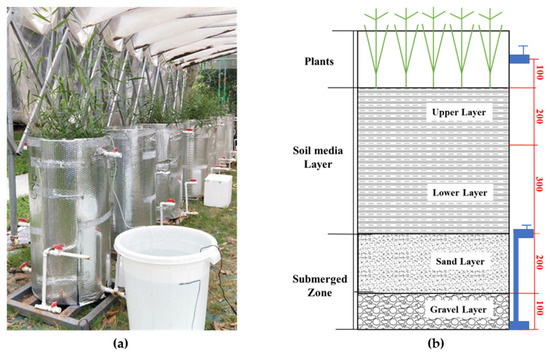
Figure 1.
Bioretention columns: (a) experimental site pictures and (b) structure schematic diagram (unit: mm).
2.2. Synthetic Rainwater Runoff
To exclude the influence from the fluctuation of nitrogen concentration and other components in the natural influent, a synthetic runoff was used in our experiments. Based on the characteristics of rainfall frequency, runoff intensity and runoff water quality in Shenzhen, this study selected a rainfall intensity of 20 mm/h, duration of one hour and a runoff coefficient of 0.9 to design the synthetic runoff of the bioretention cells. Each column was domesticated with simulated stormwater runoff (2.5 mg L−1 NH4-N, 2.5 mg L−1 NO3-N, 5.0 mg L−1 Org-N, 200 mg L−1 COD) once a week to cultivate microorganisms and grow plants for 2 months (May to June) before the formal sampling experiments.
2.3. Soil and Water Sampling
In order to study the difference in microbial characteristics in various layers of a bioretention cell, an experimental column was divided into 4 layers according to the depth from shallow to deep: upper layer (UL): 0–20 cm, lower layer (LL): 20–50 cm, sand layer (SL): 50–70 cm, gravel layer (GL): 70–80 cm (Figure 1b). Soil samples were collected in UL, LL and SL using a handheld T-type soil sampler, and each layer included five points (one at the middle and four at the surroundings). Then all collected samples were mixed as the running sample representing the entire layer. Water samples from gravel layer (GL) flowed out of the water outlet at the bottom of the system and were captured by a 1 L sterilized plastic bottle.
The sampling time was set as follows: a set of original soil samples were taken before rain; after using synthetic runoff for an artificial rainfall for 1 h, times of 4 h, 8 h, 12 h, 24 h, 48 h, 72 h, 120 h, 168 h were selected to sample the soil of the experimental system (UL, LL and SL) in the next 7-day dry period. In addition, considering the limited volume of intercepted water, water samples in the GL were collected through the drainage hole at the bottom of the experimental column at 24 h, 48 h, 72 h and 120 h. The collected soil and water samples were divided into two parts immediately after collection, one for the chemical analysis, and the other for microbial analysis.
2.4. Microbial Analysis
Total genomic DNA from soil samples was extracted using PowerSoil DNA Isolation Kits (MoBio Laboratories, CA, USA), and total genomic DNA from water samples was extracted using PowerWater DNA Isolation Kits (MoBio Laboratories, CA, USA), following the manufacturers’ protocols. The extracted DNA was sent to biological company for bioinformatics analysis, including high-throughput sequencing of 16S rRNA genes and real-time qPCR of functional genes.
2.4.1. High-Throughput Sequencing and Data Processing
High-throughput sequencing was completed by Illumina Miseq2000 system. The raw data from high-throughput sequencing was processed by QIIME (http://qiime.org/, accessed on 23 September 2019). The combination of paired-end reads was finished with FLASH software. Operational taxonomic units (OTUs) with 97% similarity were clustered using Uclust algorithm. BLASTn (https://blast.ncbi.nlm.nih.gov/Blast.cgi, accessed on 23 September 2019) was used to analyze the representative sequence of each OTU and select the closest related sequences from NCBI (National Center for Biotechnology Information).
2.4.2. Quantitative Real-Time PCR
Real-time fluorescence quantitative PCR was used to quantify the following N-related functional genes: amoA genes of ammonia-oxidizing archaea and bacteria (AOA and AOB, respectively, for aerobic NH4+ oxidization), narG gene (for NO3− → NO2−), nirK and nirS genes (for NO2− → NO) and nosZ gene (for N2O → N2). The primer and probe sequences are included in Table A1. All designed primers were synthesized and verified by Majorbio Bio-pharm Technology Co., Ltd. (Shanghai, China). The amplification of gene fragments was performed on a 96-well thermal cycler (Life Technologies, Carlsbad, CA, USA) using the designed primers and rTaq DNA polymerase (Takara, Japan) according to the manufacturer’s recommendations. The PCR products were verified by electrophoresis in 0.8% agarose gel using an FR-980A gel image analysis system (Furi Technology, Fuzhou, China).
The specificity of amplification was tested by melting curve analysis. Each standard curve was created by ten-fold serial dilutions of plasmids containing target gene. Reaction efficiencies were between 84% and 105%, and the R2 value of each standard curve was greater than 99%.
Real-time PCR was performed on an ABI 7500 real-time PCR system (Life Technologies, Carlsbad, CA, USA). Amplification reactions were performed in a volume of 20 μL and the reaction mixture contained 10 μL 2X Taq Plus Master Mix (Vazyme, Nanjing, China), 0.8 μL primers (5 mol/L), 1 μL templates DNA (sample nucleic acid extracts or plasmid DNA for standard curves) and 7.4 μL RNase-free water.
2.5. Chemical Analysis
NH4+ and NO3− concentrations were measured using the CleverChem 200+ automatic discontinuous analyzer based on the monitoring methods of Nessler’s reagent spectrophotometry and hydrazine sulfate-NEDD spectrophotometry, respectively. Total organic carbon (TOC), total nitrogen (TN), total carbon (TC) and carbon to nitrogen ratio (C/N) were measured using a vario MACRO cube elemental analyzer (Elementar Co., Ltd., Hanau, Germany). In addition, water content was measured by comparing sample weights before and after drying and pH was measured by laboratory pH meter (PHS-3C, LEICI, China).
2.6. Statistical Analysis
In this study, Mothur software was performed to obtain α-diversity indices (Chao1 and Shannon index). Spearman tests were performed to confirm the correlations between functional genes and environmental factors using SPSS 24.0 software (SPSS Inc., Chicago, IL, USA).
3. Results and Discussion
3.1. Richness and Diversity of Microbial Community
A total of 27 soil samples were obtained during a wet and dry cycle from the UL, LL and SL, and four water samples were obtained from the GL. The high-throughput sequencing information of samples in different layers is shown in Table A2. The OTUs and Shannon index fluctuated within 24 h and showed a certain regularity after 24 h (Figure 2). During the gradual drying, it can be seen that the microorganisms in the submerged zone, especially those in the GL, had greater changes than those in the soil layer. Specifically, the microorganisms in the GL had a significant decrease in OTUs but a significant increase in diversity, and the Shannon index at 120 h was 2.23 times that at 24 h. In contrast, OTUs slightly decreased and diversity grew slightly in the SL, and the Shannon index of samples from the UL, LL and SL ranged from five to six with small fluctuations. In view of the movement of moisture and transport of solute being unique to the submerged zone, it can be concluded that the differences in microbial characteristics may be related to the existence of alternating old and new water and the rapid consumption of nutrients in the submerged zone.
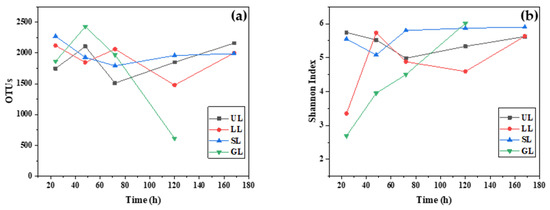
Figure 2.
Changes in (a) OTUs and (b) Shannon index of samples drying for 24–168 h after rain.
As shown in Figure 3, the distribution of microbial species (phylum level) in different layers during a dry period was analyzed. The top 10 bacteria groups (accounting for more than 0.1% of the total bacteria abundance in each sample) found in both initial samples and post-rain samples included Proteobacteria, Actinobacteria, Chloroflexi, Firmicutes, Acidobacteria, Bacteroidetes, Patescibacteria, Epsilonbacteraeota, Planctomycetes and Lentisphaerae, the relative proportion of which exceeded 95%.
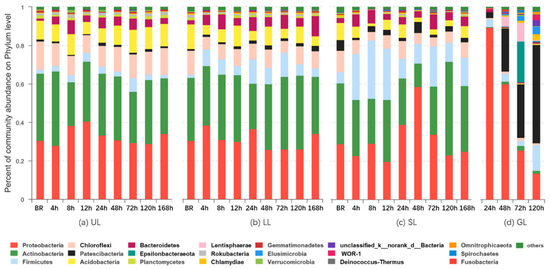
Figure 3.
Changes in microbial community structure in (a–d) during a dry period (phylum level).
Among the main microbial species above, some are related to the removal of nitrogen and organics. Proteobacteria occupied an absolute advantage in the entire system, the relative abundance of which peaked at 12 h in the UL, 48 h in the SL and 24 h in the GL. Li et al. [26] and Broman et al. [27] pointed out that the most common denitrifying bacteria in various environments belonged to the family of Proteobacteria. Studies have shown that β-Proteobacteria is the most abundant microorganism in denitrifying activated sludge systems [28,29]. The abundance of Firmicutes in the LL and SL increased steadily towards the peak after rainfall. In addition, Firmicutes is one of the Gram-positive bacteria that can metabolize in the aerobic or anoxic environment and participate in the nitrification and denitrification processes [30,31]. Bacteroidetes is an obligate anaerobic microorganism, which is beneficial to the promotion of the utilization of nitrogenous substances, the biotransformation of steroids and the hydrolysis of macromolecular substances [32]. Acidobacteria is related to the humus breakdown in the carbon cycle [33], which may provide energy for the metabolic activity of other bacteria.
From Figure 3d, it can be seen that there was a significant change in the community structure of microorganisms in the saturated zone within 24–120 h after rainfall. The proportion of the Proteobacteria in the main species was as high as 89.6% at 24 h. With the prolongation of the dry period, the relative abundance decreased rapidly to 13.7%, which may indicate that the peak time of denitrification occurred around 24 h and ended after 48 h after rain. In contrast, the proportion of Patescibacteria increased and accounted for about half of the abundance of the community in the GL during the dry period. In addition, Patescibacteria is an aquatic phylum and can survive under poor nutrition conditions [34], and has been found in Yellow Sea coasts [35], which may explain why Patescibacteria was rare in the UL, LL and SL. On the other hand, it can illustrate that nutrients in the submerged area such as N and organic carbon may have been decomposed by microorganisms.
The amount of microbes at the genus level in different layers with drought times of 1, 2, 3 and 5 days after rain were compared (Figure 4). With the increment in drought time, the number of microbial species in the UL, LL and SL all fluctuated around 500, and the number of microbial species in the GL increased continuously. Moreover, the number of microbial species shared by the four layers increased. At 24 h after rainfall, the number of species in the GL and common species in all layers were only 324 and 154, respectively (Figure 4a). In contrast, the number of species in the GL was about 500 at 5 days after rain, and the number of species shared by four layers reached 231, accounting for approximately half the species of each layer (Figure 4d). To sum up, there was almost no change in the amount of species in the soil samples during the dry period; with the extension of the dry period, the diversity of microbes in the water samples increased, and the number of species shared by all four layers also increased, showing a convergent succession of microorganisms.
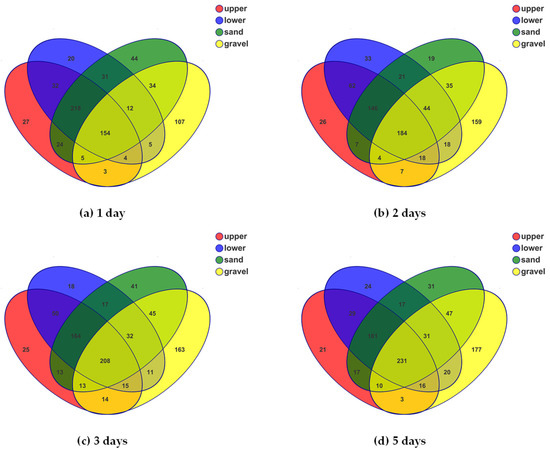
Figure 4.
Venn diagram of microbial species in different layers of the bioretention at (a–d) after rain (genus level).
Further analysis was performed at genus level to analyze the relative abundance of microbial genera in different layers of the bioretention. As shown in the heatmap of the genus abundance clustering tree (Figure 5), the microbes in the GL were distinguished from those in the other three layers due to its special microbial community structure. The specific genera in the GL included Enterobacteriaceae and Tolumonas, which accounted for a significant proportion of genera in the GL but a negligible proportion of genera in the UL, LL and SL. In addition, the microbial community structure of the SL in the submerged zone was significantly different from that of the soil layers, and the dominant microbial genera were unique to SL, including Enterobacter, Domibacillus and Acinetobacter. The former two genera are Gram-negative facultative anaerobic bacilli, while Acinetobacter is an aerobic bacteria. The high abundance of facultative and aerobic bacteria in the SL indicated that the microbes in this layer were greatly affected by the alternating dry and wet environment and had developed a certain adaptability in response to such environmental stress.
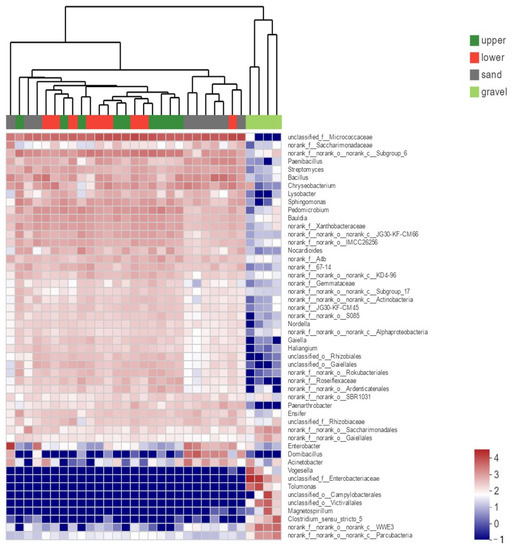
Figure 5.
Heatmap of microbes in samples of different layers within the bioretention cell (genus level).
3.2. Quantification of and Variation in Nitrification and Denitrification Functional Genes
Figure 6 shows the concentration of nitrification and denitrification functional genes in soil samples (samples of the UL, LL, SL) collected from the BRC. On the whole, the concentration of denitrifying genes in the BRC was higher than that of nitrifying genes. The functional gene with the highest average abundance in soil samples was narG, with an average abundance close to 1 × 108 (copies/g) and a maximum abundance reaching 3.7 × 108 (copies/g). The functional gene with the lowest average abundance was amoA-AOB, which was hard to find in soil samples of the SL due to its anaerobic environment.
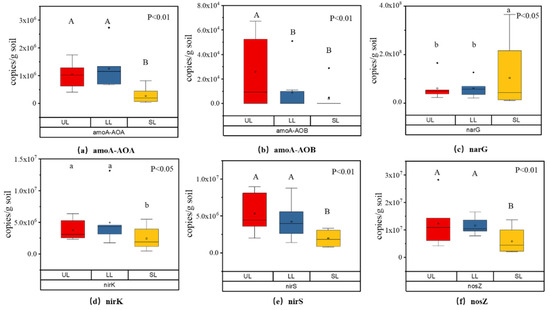
Figure 6.
The abundance of nitrification and denitrification functional genes in different soil layers including the (a–f). Different letters denote significant difference between gene abundance in layers (one-way ANOVA, n = 3).
Comparing the abundance of two ammonia oxidation function genes, it can be found that the abundance of amoA-AOA gene was about 106 (copies/g), which was significantly greater than that of amoA-AOB. Therefore, the experimental system was more suitable for the survival of amoA-AOA than amoA-AOB. Studies have shown that the microaerobic environment and exudates of plant roots are more conducive to the survival of AOA and AOB [24,36], which can also explain why the nitrifying bacteria were mainly concentrated in the UL.
It should be noted that the abundance of nirK, nirS and nosZ in the UL and LL was higher than that in the SL, which was inconsistent with the previous research experience. In the past, more people thought that the anaerobic condition of the deep soil layer might be better, and there would be more anaerobic microorganisms [37,38]. Nevertheless, it can hardly be denied that the upper layer of the soil also has the potential to form an anaerobic microenvironment under the high-frequency rainfall condition of this study, which is a possible explanation for this result.
The abundance of functional genes in water samples of the gravel layer was significantly different from that of the soil samples (Figure 7). The average abundance of functional genes of denitrifying bacteria was 100 times greater than that of nitrifying bacteria due to the completely anaerobic environment of the gravel layer. In addition, amoA-AOB accounted for the lowest proportion of functional genes in the GL, and were not even detected. Although nirS and nirK genes catalyze the same key step in the denitrification process together, functional genes of denitrifying bacteria in the gravel layer were dominated by the nirS gene.
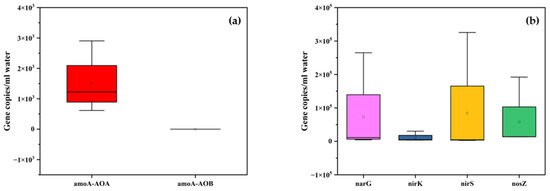
Figure 7.
The abundance of (a) nitrification functional genes and (b) denitrification functional genes in gravel layer.
The changes in the absolute abundance of amoA-AOA, narG, nirK, nirS and nosZ in four layers during the dry period are shown in Figure 8. The concentration of amoA-AOB was sometimes too low to detect and was not compared here. On the whole, the abundance of functional genes in the SL and GL located in the submerged zone fluctuated with obvious characteristics. Specifically, the abundance of functional genes in the SL increased after rainfall and then peaked at 24–48 h, after which it decreased and tended to be stable. The abundance of functional genes in the GL was high in the early period after rain (within 24 h), and then decreased rapidly with the extension of the dry period, which may be associated with the dramatic changes in water content and nutrients in the GL during the dry period. In consideration of the fact that flowing water may no longer exist in the GL when drying for over 120 h after rainfall under the influence of evaporation and capillary, hence drying for too long is not beneficial to maintain the nitrogen removal ability of the bioretention cell. In contrast, nitrification continued to occur throughout the dry period, especially in the UL and LL of the system.
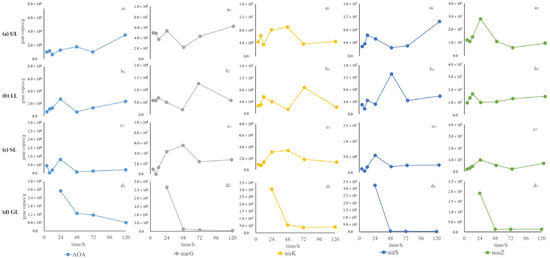
Figure 8.
Variations in nitrification and denitrification function genes in (a–d) of the bioretention cell within 120 h after rainfall.
3.3. Environmental Factors Affecting the Abundance of Functional Genes
In this study, the pH value of the soil samples was between 6.64 and 7.95, and it remained almost neutral during the dry period. The water content in the soil layers and sand layer increased initially, but the average water content in each layer decreased with the prolonged dry period, maybe due to the evaporation and plant root absorption. The TOC content in the SL was much lower than that in the UL and LL, which may be related to the difference between the soil medium and the sand medium; in other words, the organic matter in the SL mainly depended on an external supply. For the same reason, the TOC of the SL accumulated with the infiltration of runoff within 8 h after rain, and then gradually decreased, which was possibly assimilated by microorganisms as a carbon source.
The nitrogen cycle microorganisms in the bioretention cell were strongly affected by environmental factors (Table 1). TOC, nitrate nitrogen concentration and ammonia nitrogen concentration were the top three determinant influencing factors, affecting almost all microorganisms participating in the processes of nitrogen fixation–nitrification–denitrification. Among the five functional genes above, the amoA-AOA gene and nirK gene were more susceptible to environmental factors, which were related to the reaction processes of nitrification and denitrification, respectively.

Table 1.
The spearman correlations between the abundances of nitrification and denitrification functional genes and soil properties.
4. Conclusions
In this study, the variations in the microbial community and functional genes related to nitrogen transformation during a dry period were investigated based on an experiment in a bioretention cell with a submerged zone. The main results obtained can be summarized as follows:
- (1)
- The richness and diversity of microbes in the gravel layer showed the highest variation during a dry period, and the microbial community structure of the gravel layer at phylum or genus level was also distinguished from those of the other three layers. With the extension in drought time, the amount of microbial species shared by all four layers increased, showing a convergent succession of microorganisms.
- (2)
- The abundance of nitrification and denitrification functional genes mainly decreased with the depth of soil, and the abundance of denitrifying genes was higher than that of nitrifying genes. The variations in functional genes in different layers during the dry period indicated that the most active period of denitrification in the submerged zone may be 0–48 h after rainfall, and nitrification continued to occur throughout the dry period, especially in the UL and LL.
- (3)
- The abundance of nitrification and denitrification functional genes was significantly affected by TOC, ammonia nitrogen concentration and nitrate nitrogen concentration. Among the functional genes studied, amoA-AOA gene and nirK gene were more susceptible to environmental factors in this system.
Author Contributions
Conceptualization, X.L. and H.Q.; methodology, X.L. and H.Q.; investigation, X.L., Y.S. and W.D.; writing—original draft preparation, X.L. and Y.S.; writing—review and editing, C.X. and H.Q.; funding acquisition, H.Q. All authors have read and agreed to the published version of the manuscript.
Funding
This research was supported by the National Natural Science Foundation of China (52070003) and Science and Technology Planning Project of Shenzhen Municipality, China (JCYJ20200109120416654).
Acknowledgments
The Rainwater Resources Laboratory provided experimental conditions for this paper, and the authors are deeply grateful to Ke Yu and Li Wang for helping with the analysis.
Conflicts of Interest
The authors declare no conflict of interest.
Appendix A

Table A1.
The primer and probe sequences of target genes.
Table A1.
The primer and probe sequences of target genes.
| Target Gene | Primer | 5′-3′ |
|---|---|---|
| amoA-AOA | Arch-amoAF | STAATGGTCTGGCTTAGACG |
| Arch-amoAR | GCGGCCATCCATCTGTATGT | |
| amoA-AOB | amoA-1F | GGGGTTTCTACTGGTGGT |
| amoA-2R | CCCCTCKGSAAAGCCTTCTTC | |
| narG | narG-f | TCGCCSATYCCGGCSATGTC |
| narG-r | GAGTTGTACCAGTCRGCSGAYTCSG | |
| nirK | FlaCu | ATCATGGTSCTGCCGCG |
| R3Cu | GCCTCGATCAGRTTRTGGTT | |
| nirS | Cd3aF | GTSAACGTSAAGGARACSGG |
| R3cdR | GASTTCGGRTGSGTCTTGA | |
| nosZ | nosZ-1F | CGYTGTTCMTCGACAGCCAG |
| nosZ-1622R | CGSACCTTSTTGCCSTYGCG |

Table A2.
Summary of soil sample groupings and high-throughput sequencing information of the bioretention cell.
Table A2.
Summary of soil sample groupings and high-throughput sequencing information of the bioretention cell.
| Sampling Periods | Sampling Layers | Sample Number | Drought Time | OTUs | Chao1 Index | Shannon Index | Coverage Rate % |
|---|---|---|---|---|---|---|---|
| Before rainfall | Upper layer | U-BR | - | 1926 | 2313.69 | 5.35 | 98% |
| Lower layer | L-BR | - | 1959 | 2488.94 | 5.63 | 98% | |
| Sand layer | S-BR | - | 2058 | 2603.01 | 5.07 | 98% | |
| After rainfall | Upper layer | U4 | 4 h | 1846 | 2096.44 | 6.01 | 99% |
| U8 | 8 h | 1964 | 2699.46 | 5.36 | 98% | ||
| U12 | 12 h | 1999 | 2111.04 | 4.56 | 99% | ||
| U24 | 24 h | 1747 | 2351.10 | 5.74 | 98% | ||
| U48 | 48 h | 2106 | 2728.91 | 5.52 | 98% | ||
| U72 | 72 h | 1511 | 2663.49 | 4.98 | 98% | ||
| U120 | 120 h | 1849 | 2387.02 | 5.33 | 99% | ||
| U168 | 168 h | 2158 | 2379.72 | 5.62 | 98% | ||
| After rainfall | Lower layer | L4 | 4 h | 2011 | 2646.28 | 5.59 | 98% |
| L8 | 8 h | 1841 | 2285.22 | 5.62 | 98% | ||
| L12 | 12 h | 1916 | 2665.33 | 5.41 | 98% | ||
| L24 | 24 h | 2120 | 2094.33 | 3.35 | 98% | ||
| L48 | 48 h | 1848 | 2476.22 | 5.73 | 98% | ||
| L72 | 72 h | 2062 | 2505.95 | 4.88 | 98% | ||
| L120 | 120 h | 1478 | 2144.66 | 4.59 | 98% | ||
| L168 | 168 h | 2000 | 2463.10 | 5.63 | 99% | ||
| After rainfall | Sand layer | S4 | 4 h | 1975 | 2817.94 | 5.33 | 99% |
| S8 | 8 h | 1683 | 2581.28 | 4.66 | 98% | ||
| S12 | 12 h | 2080 | 2277.11 | 5.64 | 99% | ||
| S24 | 24 h | 2271 | 2551.69 | 5.55 | 98% | ||
| S48 | 48 h | 1928 | 2602.53 | 5.08 | 98% | ||
| S72 | 72 h | 1791 | 2423.27 | 5.80 | 98% | ||
| S120 | 120 h | 1959 | 2391.61 | 5.87 | 98% | ||
| S168 | 168 h | 1989 | 2587.41 | 5.90 | 98% | ||
| After rainfall | Gravel layer | G24 | 24 h | 1865 | 1428.01 | 2.69 | 99% |
| G48 | 48 h | 2428 | 2359.39 | 3.95 | 99% | ||
| G72 | 72 h | 1969 | 2382.69 | 4.50 | 99% | ||
| G120 | 120 h | 614 | 2521.88 | 6.01 | 99% |
References
- Payne, E.G.I.; Fletcher, T.D.; Cook, P.L.M.; Deletic, A.; Hatt, B.E. Processes and Drivers of Nitrogen Removal in Stormwater Biofiltration. Crit. Rev. Environ. Sci. Technol. 2014, 44, 796–846. [Google Scholar] [CrossRef]
- Davis, A.P.; Hunt, W.F.; Traver, R.G.; Clar, M. Bioretention Technology: Overview of Current Practice and Future Needs. J. Environ. Eng. 2009, 135, 109–117. [Google Scholar] [CrossRef]
- McPhillips, L.; Goodale, C.; Walter, M.T. Nutrient Leaching and Greenhouse Gas Emissions in Grassed Detention and Bioretention Stormwater Basins. J. Sustain. Water Built Environ. 2018, 4, 04017014. [Google Scholar] [CrossRef]
- Hatt, B.E.; Fletcher, T.D.; Deletic, A. Hydrologic and pollutant removal performance of stormwater biofiltration systems at the field scale. J. Hydrol. 2009, 365, 310–321. [Google Scholar] [CrossRef]
- LeFevre, G.H.; Paus, K.H.; Natarajan, P.; Gulliver, J.S.; Novak, P.J.; Hozalski, R.M. Review of Dissolved Pollutants in Urban Storm Water and Their Removal and Fate in Bioretention Cells. J. Environ. Eng. 2015, 141, 04014050. [Google Scholar] [CrossRef]
- Chen, X.L.; Peltier, E.; Sturm, B.S.M.; Young, C.B. Nitrogen removal and nitrifying and denitrifying bacteria quantification in a stormwater bioretention system. Water Res. 2013, 47, 1691–1700. [Google Scholar] [CrossRef]
- Waller, L.J.; Evanylo, G.K.; Krometis, L.-A.H.; Strickland, M.S.; Wynn-Thompson, T.; Badgley, B.D. Engineered and Environmental Controls of Microbial Denitrification in Established Bioretention Cells. Environ. Sci. Technol. 2018, 52, 5358–5366. [Google Scholar] [CrossRef]
- Wan, Z.; Li, T.; Shi, Z. A layered bioretention system for inhibiting nitrate and organic matters leaching. Ecol. Eng. 2017, 107, 233–238. [Google Scholar] [CrossRef]
- Zhang, Z.; Li, J.; Li, Y.; Wang, D.; Zhang, J.; Zhao, L. Assessment on the cumulative effect of pollutants and the evolution of micro-ecosystems in bioretention systems with different media. Ecotoxicol. Environ. Saf. 2021, 228, 112957. [Google Scholar] [CrossRef]
- Borken, W.; Matzner, E. Reappraisal of drying and wetting effects on C and N mineralization and fluxes in soils. Glob. Chang. Biol. 2009, 15, 808–824. [Google Scholar] [CrossRef]
- Denef, K.; Six, J.; Bossuyt, H.; Frey, S.D.; Elliott, E.T.; Merckx, R.; Paustian, K. Influence of dry–wet cycles on the interrelationship between aggregate, particulate organic matter, and microbial community dynamics. Soil Biol. Biochem. 2001, 33, 1599–1611. [Google Scholar] [CrossRef]
- Denef, K.; Six, J.; Paustian, K.; Merckx, R. Importance of macroaggregate dynamics in controlling soil carbon stabilization: Short-term effects of physical disturbance induced by dry–wet cycles. Soil Biol. Biochem. 2001, 33, 2145–2153. [Google Scholar] [CrossRef]
- Wang, L.; Hao, D.-C.; Fan, S.; Xie, H.; Bao, X.; Jia, Z.; Wang, L. N2O Emission and Nitrification/Denitrification Bacterial Communities in Upland Black Soil under Combined Effects of Early and Immediate Moisture. Agriculture 2022, 12, 330. [Google Scholar] [CrossRef]
- Chen, Y.; Shao, Z.; Kong, Z.; Gu, L.; Fang, J.; Chai, H. Study of pyrite based autotrophic denitrification system for low-carbon source stormwater treatment. J. Water Process Eng. 2020, 37, 101414. [Google Scholar] [CrossRef]
- He, K.M.; Qin, H.P.; Wang, F.; Ding, W.; Yin, Y.X. Importance of the Submerged Zone during Dry Periods to Nitrogen Removal in a Bioretention System. Water 2020, 12, 876. [Google Scholar] [CrossRef]
- Liu, L.; Wang, F.; Xu, S.; Sun, W.; Wang, Y.; Ji, M. Woodchips bioretention column for stormwater treatment: Nitrogen removal performance, carbon source and microbial community analysis. Chemosphere 2021, 285, 131519. [Google Scholar] [CrossRef]
- Wang, F.; Li, J.; Duan, H. A sulfur-limestone bioretention system for stormwater treatment: Nitrogen removal performance and microbial community. Sci. Total Environ. 2022, 827, 154301. [Google Scholar] [CrossRef]
- Dietz, M.E.; Clausen, J.C. Saturation to Improve Pollutant Retention in a Rain Garden. Environ. Sci. Technol. 2006, 40, 1335–1340. [Google Scholar] [CrossRef]
- Søberg, L.C.; Viklander, M.; Blecken, G.-T. Do salt and low temperature impair metal treatment in stormwater bioretention cells with or without a submerged zone? Sci. Total Environ. 2017, 579, 1588–1599. [Google Scholar] [CrossRef]
- Zhang, Z.; Rengel, Z.; Liaghati, T.; Antoniette, T.; Meney, K. Influence of plant species and submerged zone with carbon addition on nutrient removal in stormwater biofilter. Ecol. Eng. 2011, 37, 1833–1841. [Google Scholar] [CrossRef]
- Zinger, Y.; Blecken, G.-T.; Fletcher, T.D.; Viklander, M.; Deletić, A. Optimising nitrogen removal in existing stormwater biofilters: Benefits and tradeoffs of a retrofitted saturated zone. Ecol. Eng. 2013, 51, 75–82. [Google Scholar] [CrossRef]
- Kim, H.H.; Seagren, E.A.; Davis, A.P. Engineered bioretention for removal of nitrate from stormwater runoff. Water Environ. Res. 2003, 75, 355–367. [Google Scholar] [CrossRef] [PubMed]
- Wang, C.; Wang, F.; Qin, H.; Zeng, X.; Li, X.; Yu, S.-L. Effect of Saturated Zone on Nitrogen Removal Processes in Stormwater Bioretention Systems. Water 2018, 10, 162. [Google Scholar] [CrossRef]
- Morse, N.; Payne, E.; Henry, R.; Hatt, B.; Chandrasena, G.; Shapleigh, J.; Cook, P.; Coutts, S.; Hathaway, J.; Walter, M.T.; et al. Plant-Microbe Interactions Drive Denitrification Rates, Dissolved Nitrogen Removal, and the Abundance of Denitrification Genes in Stormwater Control Measures. Environ. Sci. Technol. 2018, 52, 9320–9329. [Google Scholar] [CrossRef] [PubMed]
- Huang, L.; Luo, J.; Li, L.; Jiang, H.; Sun, X.; Yang, J.; She, W.; Liu, W.; Li, L.; Davis, A.P. Unconventional microbial mechanisms for the key factors influencing inorganic nitrogen removal in stormwater bioretention columns. Water Res. 2021, 209, 117895. [Google Scholar] [CrossRef]
- Li, Y.; Wang, Y.; Wan, D.; Li, B.; Zhang, P.; Wang, H. Pilot-scale application of sulfur-limestone autotrophic denitrification biofilter for municipal tailwater treatment: Performance and microbial community structure. Bioresour. Technol. 2020, 300, 122682. [Google Scholar] [CrossRef]
- Broman, E.; Zilius, M.; Samuiloviene, A.; Vybernaite-Lubiene, I.; Politi, T.; Klawonn, I.; Voss, M.; Nascimento, F.J.A.; Bonaglia, S. Active DNRA and denitrification in oxic hypereutrophic waters. Water Res. 2021, 194, 116954. [Google Scholar] [CrossRef]
- Jiang, X.; Ma, M.; Li, J.; Lu, A.; Zhong, Z. Bacterial Diversity of Active Sludge in Wastewater Treatment Plant. Earth Sci. Front. 2008, 15, 163–168. [Google Scholar] [CrossRef]
- Ahmed, Z.; Lim, B.-R.; Cho, J.; Song, K.-G.; Kim, K.-P.; Ahn, K.-H. Biological nitrogen and phosphorus removal and changes in microbial community structure in a membrane bioreactor: Effect of different carbon sources. Water Res. 2008, 42, 198–210. [Google Scholar] [CrossRef]
- Guo, J.H.; Ni, B.J.; Han, X.Y.; Chen, X.M.; Bond, P.; Peng, Y.Z.; Yuan, Z.G. Unraveling microbial structure and diversity of activated sludge in a full-scale simultaneous nitrogen and phosphorus removal plant using metagenomic sequencing. Enzym. Microb. Technol. 2017, 102, 16–25. [Google Scholar] [CrossRef]
- Luo, J.; Hao, T.; Wei, L.; Mackey, H.R.; Lin, Z.; Chen, G.-H. Impact of influent COD/N ratio on disintegration of aerobic granular sludge. Water Res. 2014, 62, 127–135. [Google Scholar] [CrossRef] [PubMed]
- Lee, I.-S.; Parameswaran, P.; Rittmann, B.E. Effects of solids retention time on methanogenesis in anaerobic digestion of thickened mixed sludge. Bioresour. Technol. 2011, 102, 10266–10272. [Google Scholar] [CrossRef] [PubMed]
- Yang, Y.; Dou, Y.; An, S. Testing association between soil bacterial diversity and soil carbon storage on the Loess Plateau. Sci. Total Environ. 2018, 626, 48–58. [Google Scholar] [CrossRef]
- Li, Q.; Jia, H.; Guo, H.; Zhao, Y.; Zhou, G.; Lim, F.Y.; Guo, H.; Neo, T.H.; Ong, S.L.; Hu, J. Field Study of the Road Stormwater Runoff Bioretention System with Combined Soil Filter Media and Soil Moisture Conservation Ropes in North China. Water 2022, 14, 415. [Google Scholar] [CrossRef]
- Wang, Y.; Hu, X.; Sun, Y.; Wang, C. Influence of the cold bottom water on taxonomic and functional composition and complexity of microbial communities in the southern Yellow Sea during the summer. Sci. Total Environ. 2021, 759, 143496. [Google Scholar] [CrossRef] [PubMed]
- Chen, T.; Liu, Y.; Zhang, B.; Sun, L. Plant rhizosphere, soil microenvironment, and functional genes in the nitrogen removal process of bioretention. Environ. Sci.-Process. Impacts 2019, 21, 2070–2079. [Google Scholar] [CrossRef] [PubMed]
- Linn, D.M.; Doran, J.W. Aerobic and Anaerobic Microbial Populations in No-till and Plowed Soils. Soil Sci. Soc. Am. J. 1984, 48, 794–799. [Google Scholar] [CrossRef]
- Ebrahimi, A.; Or, D. Microbial community dynamics in soil aggregates shape biogeochemical gas fluxes from soil profiles—Upscaling an aggregate biophysical model. Glob. Chang. Biol. 2016, 22, 3141–3156. [Google Scholar] [CrossRef]
Publisher’s Note: MDPI stays neutral with regard to jurisdictional claims in published maps and institutional affiliations. |
© 2022 by the authors. Licensee MDPI, Basel, Switzerland. This article is an open access article distributed under the terms and conditions of the Creative Commons Attribution (CC BY) license (https://creativecommons.org/licenses/by/4.0/).